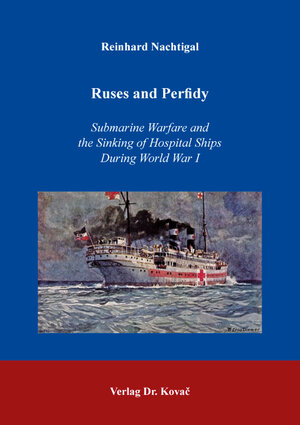
×
![Buchcover ISBN 9783339124562]()
Ruses and Perfidy – Submarine Warfare and the Sinking of Hospital Ships During World War I
von Reinhard NachtigalIn March 1916, a submarine under Turkish colors torpedoed without warning a Russian hospital ship in the Black Sea. It sank within a few minutes with a loss of over 100 lives. Whereas public mood in Russia ran high, the submarine commander argued that the ship was neither marked with prescribed signs of a hospital ship, nor that it conducted itself as such a one. For Russia the incident offered the pretext to withdraw from humanitarian projects involving POWs that had been planned since 1915 between Russia and the Central Powers. The hospital ship Portugal fell victim to naval warfare which became ever more atrocious. This development had been set off by the British Royal Navy since 1914. Looking at other cases of attacks on hospital ships during WW I, it became obvious that the early application of economic warfare and ruses by the Royal Navy had set the stage by an incident which took place in October 1914, relating to the German hospital ship Ophelia. At the centenary of WW I the case went unnoticed in historiography. The development towards total war involved issues which until now remain highly contentious in the discussion on WW I. First: Being the foremost naval power, Britain dictated very narrow rules for merchant seafaring as well as for hospital ships of the enemy. Second: No later than in 1915, Britain „waived the rules“ for seafaring that had been laid down in the decades preceding WW I. Hospital ships of the Central Powers were attacked by Entente ships and airplanes in 1915, 1916 and 1918. In 1916, the German naval command discovered that British hospital ships were in fact not used as such. British hospital ships were „dual purpose ships“. Most usually they were converted passenger liners. In Britain, before the war, these huge steamers had been built as dual purpose ships in case of war. They were designed to transport troops, matériel and/or freight, but also to serve as hospital ships. Because of sick berths and rooms for operations, hospital ships required more space than war ships. British ruses in naval warfare early on fuelled an escalation to which particularly British hospital ships increasingly fell victim after Germany declared unrestricted submarine warfare in 1917. After the German naval command found out the British system of using hospital ships for non-medical purpose horrible attacks on British hospital ships occurred, as well as war crimes. Some of these cases were dealt with in the Leipzig war crime trials of 1921-22. Also, because of the experience of using hospital ships during WWI, regulations for them were adapted and reified after the war. In a similar way the role of the submarine as an offensive means of naval warfare was adapted. This study deals with a chapter of WW I naval (submarine) war that to some extent has been treated by legal historians. It restores chronological order of events relevant for the causal story of escalation. It renders a narrative of that part of WW I history which had rarely been touched in the general discussion of submarine warfare and the use of ruses. This specific chapter of WW I has not been dealt with in such a wide scope. This investigation is based on meticulously investigated archival sources. As British official sources on the misuse of hospital ships during WW I have been either deleted or are still kept secret, only additional sources can give proof of the facts: the completely preserved German naval archives, Austrian sources, and partly Russian. The study contributes to the long-term evolvement of International Law in War.


